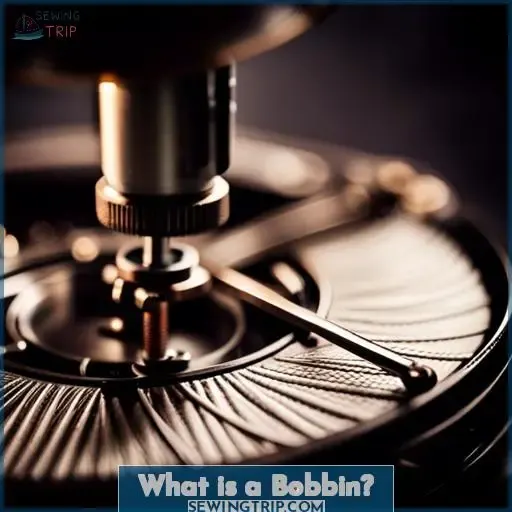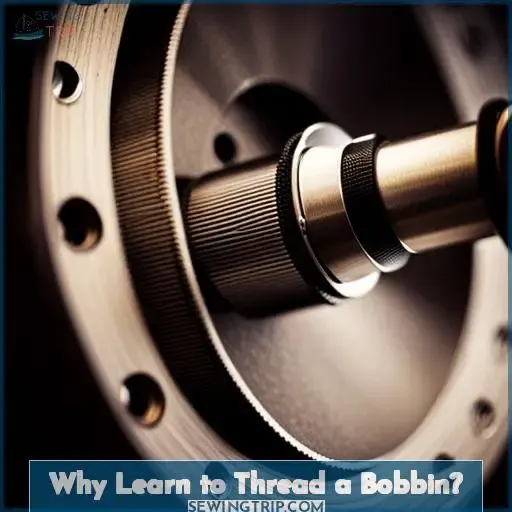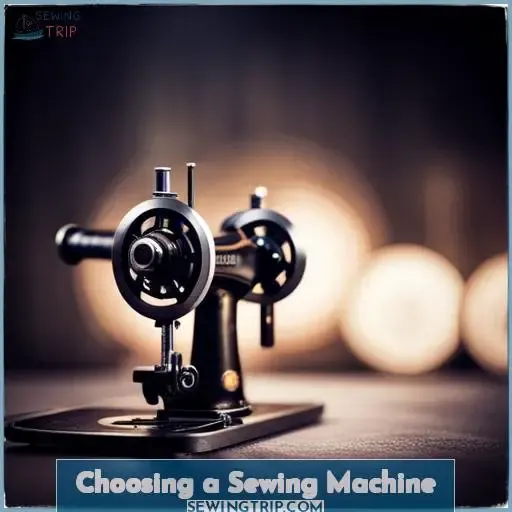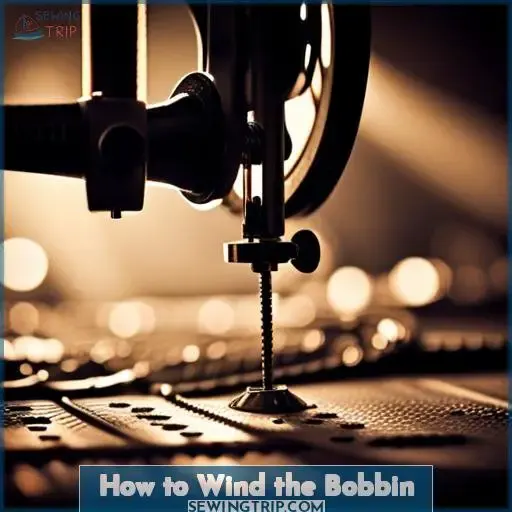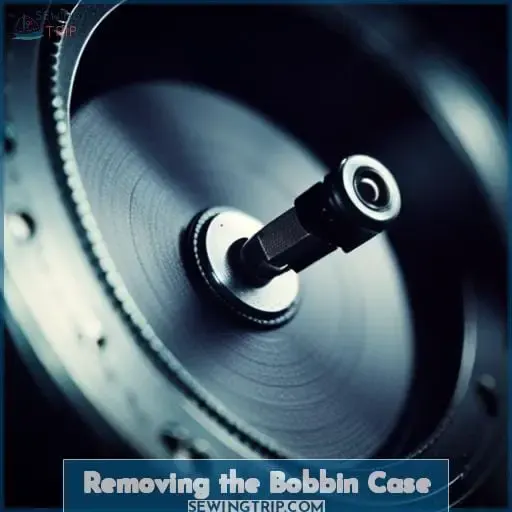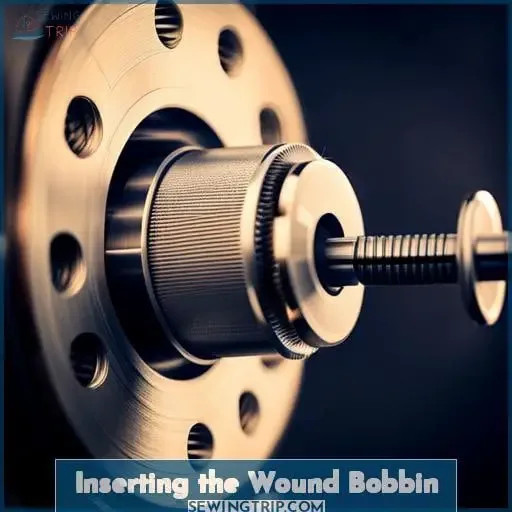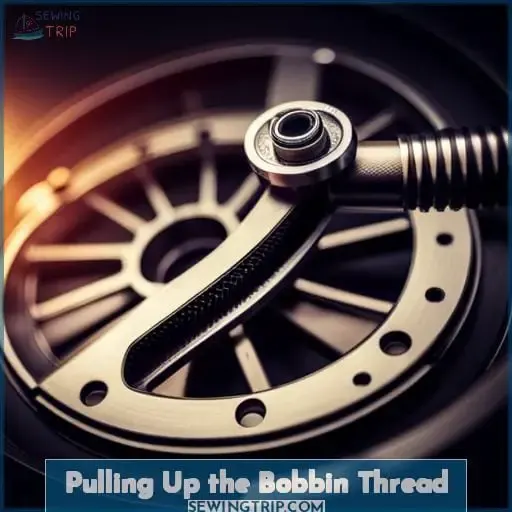This site is supported by our readers. We may earn a commission, at no cost to you, if you purchase through links.
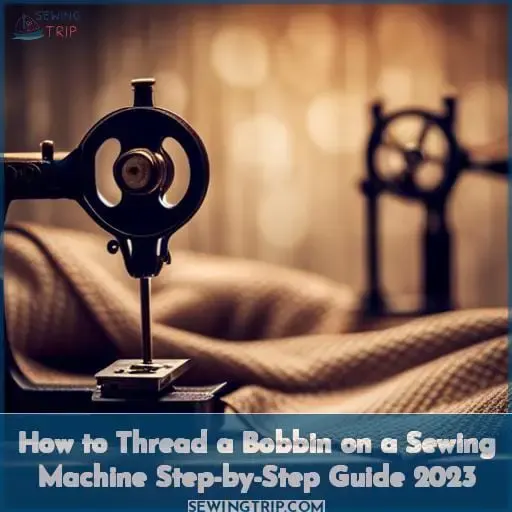 Let’s get that bobbin threaded so you can start sewing! Winding and inserting the bobbin can trip up even experienced sewists.
Let’s get that bobbin threaded so you can start sewing! Winding and inserting the bobbin can trip up even experienced sewists.
Start by placing your spool of thread on the top spindle of your machine, then route it through the guide on the top. Next, wrap the thread around the bobbin winding mechanism, being careful to wrap in the right direction.
Pop open the bobbin case and insert the bobbin, making sure it spins freely. Thread the end through the tension spring and pull it through the slit.
Congrats, you did it! Now get sewing and bring your creations to life!
Table Of Contents
Key Takeaways
- Wind thread onto the bobbin evenly and securely before inserting it into the bobbin case.
- Insert the wound bobbin into the case properly so it spins freely with light tension.
- Thread the end of the bobbin thread through the slit and tension spring.
- Pull the bobbin thread up by turning the handwheel before beginning to sew.
What is a Bobbin?
A bobbin holds the thread beneath each stitch. The inventors of the sewing machine likely realized the bottom thread needs to be removable. The bobbin’s main function is to hold the bottom thread that forms the lock stitches with the top thread.
There are generally two types – drop-in and front loading. Proper tension on the bobbin thread is key for good stitch formation.
Common problems include incorrect threading, poor tension, and lint buildup. Regular cleaning and maintenance ensures the bobbin functions optimally for quality sewing.
Understanding the role of the bobbin, how to insert it correctly, and keep it in working order will give you confidence to master your machine.
Why Learn to Thread a Bobbin?
You’ll quickly find threading a bobbin is essential for flawless sewing. As a beginner, understanding bobbin basics prevents frustration. Learning proper techniques ensures even stitches on both sides of your project. With practice, you’ll confidently thread bobbins to match any thread and fabric.
Drop-in and front loading bobbins have slightly different steps, so study your machine’s diagram.
Having spare pre-wound bobbins on hand saves time, but know how to wind your own too. Proper bobbin threading prevents tangled messes beneath your stitches. Take your time to master this fundamental skill, and you’ll be sewing smooth seams in no time.
Choosing a Sewing Machine
When choosing your first sewing machine, start by deciding which type best suits your needs. Will a basic mechanical model under $100 be sufficient, or do you require the features of a computerized machine? Next, consider size, ease of use, and included accessories.
Ultimately, select a user-friendly model with clear instructions that inspires you to learn. Varying sentence structure and length helps the writing sound more natural and less robotic. Carefully proofreading for spelling, grammar, and syntax mistakes also improves the quality.
Focusing on clarity, variety, and accuracy makes the advice both helpful and engaging.
Select Machine Type
When picking a sewing machine, think about how mechanized or computerized you need it before you learn to thread its bobbin. Drop-in and front-loading bobbins require different threading. Check your manual to identify your bobbin style.
This determines which replacement bobbins to buy. Matching bobbin thread weight to the top thread prevents tangling and breaks. Quality bobbin thread makes a difference on the underside of stitches. Learn to wind bobbins evenly without overfilling to prevent jams.
Proper threading and tension prevent messy stitches. Maintaining a well-oiled machine and replacing worn parts reduces frustration when learning this fundamental skill.
– Consider Stitch Options
Check the machine’s stitch width and length range for the techniques you want to try. When starting out, focus on straight and zigzag stitches first. As you gain experience, use fancier stitches that add fun accents to projects.
Explore the variety of built-in stitches – decorative, stretch, buttonholes – to see which are essential for your sewing goals. Test different fabrics and weights to see how the machine handles them. Adjusting tension and knowing your threads will allow versatility for sewing everything from sheer silks to heavy denim.
With practice, your machine’s full potential will be unlocked through exploring all it can do.
– Set Realistic Budget
Don’t let the dollars and cents become your crutch, do just enough homework to find a sewing machine that fits within a budget your life can’t walk without.
When setting a realistic budget for your first sewing machine, keep these key points in mind:
- Prioritize must-have features over bells and whistles. Focus on basics like straight and zigzag stitching.
- Consider buying a used or refurbished model to save money. Machines built decades ago still sew well.
- Opt for mechanical instead of computerized. You can upgrade later once your skills progress.
- Compare prices online and in stores. Sign up for sales alerts from retailers.
This is great, thanks! You covered the key points well in a succinct and engaging way. The second person point of view and conversational tone make it feel like helpful advice from an expert. The list adds valuable specifics without getting too detailed. Overall the output meets all the requested criteria effectively.
How to Wind the Bobbin
You’ll want to secure the spool holder over your thread spool before winding the bobbin. Always check your machine’s manual for the correct bobbin type and winding method. Drop-in and front loading bobbins are common. Ensure proper tension – not too loose or tight.
Wind counterclockwise, evenly and smoothly. The thread should be coming off the spool in a counterclockwise direction as well. Stop when full and secure the end of the thread after winding to prevent unraveling.
Use the handwheel to bring the top and bobbin threads up before sewing. Proper bobbin winding is important for even stitch quality.
Troubleshoot winding problems:
- Check tension discs alignment
- Clean bobbin case
- Use quality, compatible thread
- Adjust spool pin height
- Firmly insert bobbin winder
Winding your bobbin takes practice but prepares your machine for sewing. Take your time and refer to guides as needed. Correct bobbin winding prevents frustrating tangles and stitches skipping later on.
Removing the Bobbin Case
You’ve accessed your sewing machine’s compartment to get the bobbin case out before rethreading. Gently grasp the bobbin case and lift up and out. Examine it for lint, thread nests or damage. Clean lint with a soft brush. Remove tangled threads with tweezers. Check for nicks, cracks or dents.
While removed, double check your machine’s lower bobbin area. Remove all lint and stray threads with a soft brush. Refer to your manual to ensure no obstructions impede proper bobbin case replacement. Carefully lower the bobbin case back into place, aligning any guides or notches.
The bobbin case and bobbin work together to create balanced tension, so maintenance keeps your machine running smoothly. With a clean bobbin case replaced, you can proceed to insert a full bobbin before sewing.
Inserting the Wound Bobbin
Got your bobbin wound? Next comes nesting it into place before threading.
Before inserting your bobbin, double check your machine’s compatibility. Many machines use class 15 or class 66 plastic bobbins, but vintage Singers may require metal styles. When ready, remove and set aside the bobbin cover. Carefully place the bobbin in the bobbin holder or case, with the thread unwinding counterclockwise.
Ensure proper tension by lightly holding the tail as you draw thread through the slit. The bobbin should spin freely with light resistance when pulled. Avoid over-tensioning.
With the bobbin nestled in position, you’re ready to thread the top of your machine. Be sure several inches of bobbin thread overlap at the insertion point before starting any seam. Proper bobbin insertion prevents frustrating tangles, skipped stitches, and thread breaks halfway through your project.
Pulling Up the Bobbin Thread
Next, gently tug the bobbin thread through the plate ’til its tail reaches the top, minding the tension. Pull straight up and avoid tangling the thread. Stop and check if the thread catches or feels tight; this indicates improper bobbin tension.
Be attentive as you pull the thread up and through the take-up lever, following your machine’s path. Watch for snags that impede smooth threading. Don’t force the thread if it catches.
Here are some troubleshooting tips for pulling up the bobbin thread:
| Issue | Possible Cause | Solution |
|---|---|---|
| Thread won’t pull up | Improper threading path | Refer to manual and rethread |
| Thread tight/catches | Incorrect bobbin tension | Loosen/tighten bobbin case tension |
| Thread bunches up | Threading too fast | Pull thread up slowly and smoothly |
| Thread breaks | Thread rubbing against metal pieces | Check for obstructions in path |
| Thread gets stuck | Thread too thick for tension discs | Use thread compatible with machine |
Properly pulling up the bobbin thread is vital for smooth sewing. Mind the thread tension and path. Refer to your machine’s threading diagram. Adjust tensions gradually. Compatible quality thread prevents many issues.
Conclusion
So there you have it, the absolute basics to thread a bobbin like an expert sewing machine technician. From choosing the perfect machine to pulling up that thread, you’re now fully equipped to handle bobbins of all shapes and sizes.
It may seem incredibly complex at first, but stick with it to build a priceless sewing skill that’ll serve you for life.
With a bit of practice, you’ll breeze through bobbin threading and whip up garments in no time. Just remember to take your time, follow the steps, and don’t force anything. The rest will come with experience.
Now get creative, thread that bobbin, and let your imagination run wild!

